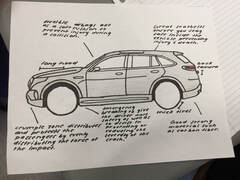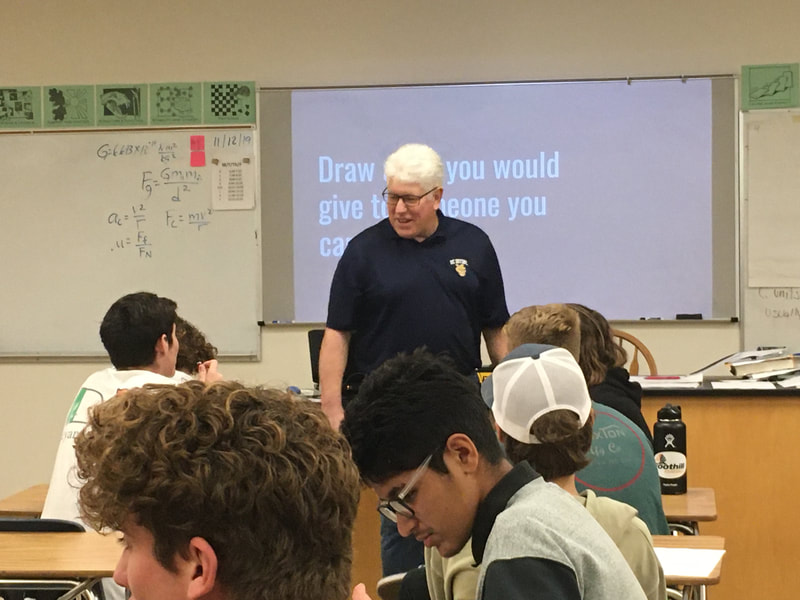How are modern cars designed to keep you and your family safe in a collision?
Overview

Unit: Momentum
Grade Level(s): 10-12
Duration: 5 Weeks
Unit Materials: Click here.
In this unit, the students design a car considering safety features for a loved one. Throughout this unit, the students focus on four main questions related to the guiding question:
(1) How can we predict the outcome of a collision?
(2) Why do some collisions cause more damage than others?
(3) How does the material influence the damage in a collision?
(4) How do safety features reduce injury during a collision?
Duration: 5 weeks
Grade Level(s): 10-12
Duration: 5 Weeks
Unit Materials: Click here.
In this unit, the students design a car considering safety features for a loved one. Throughout this unit, the students focus on four main questions related to the guiding question:
(1) How can we predict the outcome of a collision?
(2) Why do some collisions cause more damage than others?
(3) How does the material influence the damage in a collision?
(4) How do safety features reduce injury during a collision?
Duration: 5 weeks
NEXT GENERATION SCIENCE STANDARD
HS-PS2-2
HS-PS2-3
HS-ETS1-2
PS2-A. Forces and Motion
ETS1- A. Defining and Delimiting an Engineering Problem
ETS1-C. Optimizing the Design Solution
ETS1- B. Developing Possible Solutions
HS-PS2-3
HS-ETS1-2
PS2-A. Forces and Motion
ETS1- A. Defining and Delimiting an Engineering Problem
ETS1-C. Optimizing the Design Solution
ETS1- B. Developing Possible Solutions
MOMENTUM UNIT STORYLINE
This five-weeks long unit consists of 17 lessons around one essential question of "How are modern cars designed to keep you and your family safe in a collision?." A snapshot from lesson 1 of momentum unit is shown below. The overall unit storyline of the 17 lessons is linked to here. This unit covers the key concepts of momentum and impulse. It begins with students drawing a dream car for their loved one, and considering safety features that they wanted to include in order to protect the loved one in a collision (see the worksheet and samples of student work here). Students’ initial ideas about collision were assessed (link), which helped the teacher to decide how to organize the activities during the rest of the unit. While positioning students as car designers or engineers, students are tasked to design a safe car while exploring the four questions throughout the unit:
(1) How can we predict the outcome of a collision?
(2) Why do some collisions cause more damage than others?
(3) How does the material influence the damage in a collision?
(4) How do safety features reduce injury during a collision?
Students also met and talked to the invited speakers, undergraduate students who majored in engineering and were members of the auto club of a nearby university. Toward the end of the unit, students revise their car design to make it safer using new information, disciplinary languages and new understanding gained from their investigation. Students then deliver a two-minute ‘sales pitch’ to ‘judges’ (e.g., administrators, teachers, graduate students from a nearby university who studied physics, university professors). During this sales pitch, each student shows the revised model of their dream car, tells the stories of their loved one, and explains how and why the proposed design features might make the loved one safe in a collision. Students complete the final performance assessment where they engage in various scientific practices, such as developing and using models, constructing explanations, and developing arguments using evidence. The assessment task prompts students to evaluate the proposed design change of a Toyota Camry from the safety standpoint. In addition, students write a letter to their loved ones in either English or Spanish (see the examples of the letters here).
(1) How can we predict the outcome of a collision?
(2) Why do some collisions cause more damage than others?
(3) How does the material influence the damage in a collision?
(4) How do safety features reduce injury during a collision?
Students also met and talked to the invited speakers, undergraduate students who majored in engineering and were members of the auto club of a nearby university. Toward the end of the unit, students revise their car design to make it safer using new information, disciplinary languages and new understanding gained from their investigation. Students then deliver a two-minute ‘sales pitch’ to ‘judges’ (e.g., administrators, teachers, graduate students from a nearby university who studied physics, university professors). During this sales pitch, each student shows the revised model of their dream car, tells the stories of their loved one, and explains how and why the proposed design features might make the loved one safe in a collision. Students complete the final performance assessment where they engage in various scientific practices, such as developing and using models, constructing explanations, and developing arguments using evidence. The assessment task prompts students to evaluate the proposed design change of a Toyota Camry from the safety standpoint. In addition, students write a letter to their loved ones in either English or Spanish (see the examples of the letters here).
MOMENTUM UNIT SLIDES
In the unit storyline, there are many references to unit slides. Here you can find momentum unit slides for all 17 lessons.
ASSESSMENT MATERIALS
Initial Assessment - Click here.
Final Assessment- Click here.
Project (Alternative Assessment): Car design, Sales pitch, and Writing a letter to the loved ones (Click here).
Project Rubric- Click here.
Samples of student work- Click here.
Final Assessment- Click here.
Project (Alternative Assessment): Car design, Sales pitch, and Writing a letter to the loved ones (Click here).
Project Rubric- Click here.
Samples of student work- Click here.
GOOGLE DRIVE UNIT MATERIALS
Coming Soon...
CURRICULUM DEVELOPMENT
PEOPLE
- Co-designing the unit storyline & assessment: Jennifer Douglas, Paul Tschida at Tustin High School, Gregg Leslie at Foothill High School, & Hosun Kang at UCI
- Implementing the curriculum and assessment in classroom: Jennifer Douglas, Paul Tschida at Tustin High School, Gregg Leslie at Foothill High School
- Curriculum writing: Paul Tschida at Tustin High School
- Reviewing the curriculum: Lauren Snow, Stephen Skoropad, and Hosun Kang at UCI
WHAT STUDENTS SAY:
- "I had known about the crumple zone but hadn’t really researched it. So like now that that’s a new thing to like. Like you might look at this physics when you’re just looking it up and then like all of a sudden, you’re like ‘okay I’m going to go and know exactly what number’. So I think that was kind of cool..."
- "In that unit we designed a safe car for a loved one, we drew it out and labeled all the five safety features and then three other features we would do thinking of our loved ones"
- "We learned about momentum and all the crumple zones and materials of what to make out of it… Elasticity and inelasticity."









